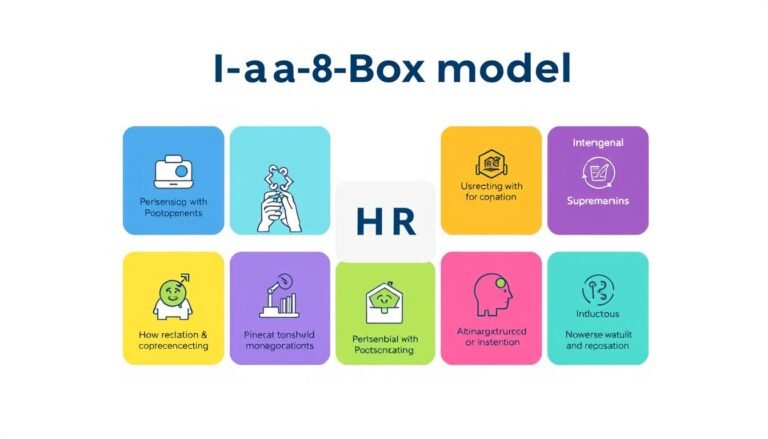Leadership Succession Planning: Securing the Future
“The greatest leader is not necessarily the one who does the greatest things. He is the one that gets the people to do the greatest things.”
– Ronald Reagan
Succession planning is key for any organization’s long-term success. In the healthcare sector, many Baby Boomers are retiring. This makes effective leadership succession planning very important. A well-thought-out approach helps organizations smoothly pass on leadership. It also builds a strong lineup of future leaders, ensuring future growth and success.
Key Takeaways:
- Effective leadership succession planning is essential for organizational continuity and future success.
- Identifying critical roles, assessing talent, and creating development plans are key elements of a successful succession plan.
- Implementing succession planning brings numerous benefits, including risk mitigation and improved decision-making.
- Starting early, effective communication, and talent pipeline development are best practices for successful succession planning.
- Neglecting succession planning can lead to a leadership vacuum, talent drain, and negative impact on stakeholders.
Investing in leadership succession planning now is investing in your organization’s future success. By being proactive and using the right strategies, you can create a strong leadership pipeline. This will make sure leadership transitions go smoothly in the future. Let’s dive into the essential elements and strategies for successful succession planning ahead.
The Importance of Succession Planning
Succession planning is key for any business’s success. It ensures that when leaders leave, others are ready to step up. This keeps the organization moving forward without a hitch.
This plan also helps with stability. When there’s no clear leader, things can get messy. Succession planning makes sure there’s always someone in line to lead.
It’s vital for talent growth too. Knowing who’s ready for more gives these individuals chances to develop further. This keeps the company strong and ready for whatever comes next.
Without a plan, risks increase. Unexpected changes can shake the company. But by planning ahead, the impact of such events can be less severe.
Succession planning is forward thinking. It’s about preparing today for tomorrow’s leadership needs. With the right people in place, success is more likely.
Key Elements of Succession Planning
Succession planning includes key steps that help organizations prepare for future leadership changes. These steps ensure a smooth transfer of roles and help companies build a strong talent base for success.
Identifying Critical Roles
It’s crucial to highlight important positions early in the planning phase. These roles are pivotal in achieving the company’s goals. Knowing which jobs are key allows companies to focus on grooming the right people to take them over.
Talent Assessment
Evaluating the talent within the organization is a key step. This process pinpoints who among the staff is ready for bigger roles based on skills and potential. It helps identify potential leaders who can fill critical roles effectively.
Development Plans for High-Potential Employees
Developing future leaders starts with creating plans to foster talent. These plans include training and opportunities that prepare employees for leadership. This investment ensures there are skilled individuals ready to step into important roles.
Addressing Skill Gaps
It’s vital to focus on filling any skill gaps future leaders may have. By pinpointing the needs and offering tailored training, companies make sure their leaders are fully prepared. This strategy equips successors to handle their roles with confidence.
Stakeholder Involvement
Engaging stakeholders is essential for an effective succession plan. Insights from senior leaders, HR professionals, and department heads are valuable. Including them ensures a complete and supported succession planning process.
“Succession planning is not just about filling important roles; it’s about developing a robust talent pipeline and addressing skill gaps to secure the organization’s future success.”
By focusing on these elements, organizations can smoothly transition leadership roles. This approach helps in long-term growth and stability.
Benefits of Succession Planning
Introducing succession planning in your company offers several benefits. This includes getting ready for leadership changes and nurturing talent inside. Doing so reduces risks and keeps the business going. Here are some of the top advantages:
1. Risk Mitigation
It lowers the threat of unexpected gaps in leadership, which can hurt the organization. By picking and training future leaders early, you build a group of skilled people. They’re prepared to take on important roles when needed.
2. Business Continuity
A good succession plan means your company won’t miss a beat when leaders change. This makes sure that everyone knows the plan and the path ahead is clear.
3. Talent Retention
It shows you’re serious about developing and promoting from your own team. This boosts loyalty and keeps employees from looking elsewhere. They can clearly see ways to grow and advance in the company.
4. Improved Decision-Making
Succession planning makes your future leaders ready with solid training. This means better, more thought-out decisions that are good for the company’s goals.
5. Employee Engagement
Involving your team in succession planning can really improve how they feel about their work. They’ll feel more valued and involved, leading to a more dedicated team.
6. Adaptation to Change
A strong plan gets your company ready for whatever the future might bring. This helps to develop a more flexible and ready team that can face new challenges easily.
Adding succession planning to your strategy does more than fill leadership roles. It strengthens your company for the future.
| Benefits of Succession Planning |
|---|
| Risk Mitigation |
| Business Continuity |
| Talent Retention |
| Improved Decision-Making |
| Employee Engagement |
| Adaptation to Change |
Succession Planning Best Practices
Succession planning is key for a smooth leadership handover and keeping operations going. Choosing the right steps early ensures the next leaders are ready. This strengthens the path for future wins. Let’s look at some top tips:
1. Starting Early
Starting early is a must. It’s about spotting who could lead next and helping them grow. This way, there’s little gap when new leaders step in. Planning ahead stops any big hitches in leadership changeovers.
2. Effective Communication
Talking clearly about the plan is vital. Everyone from current leaders to those who might be next need to know its importance. This clear talk builds unity and gets everyone on board. That’s how the plan succeeds.
3. Developing Talent Pipelines
Creators of strong pipelines always have someone ready for the next role. It goes by picking who has the most promise and giving them a map to grow. This way, leadership gaps don’t scare the team, and the work stays strong.
4. Seeking Expert Guidance
Expert help can really make a difference in creating a strong succession plan. Leaders in this field offer wise ways to beat any challenges. They can give clear advice for your specific needs.
“Succession planning is not just about filling vacancies; it is about developing the leaders of tomorrow and ensuring the long-term success of the organization.” – John Maxwell
Following these steps really lifts how well your transition plan works. With early starts, clear talks, good pipelines, and the right advice, your organization’s journey ahead is safer.
| Benefits of Succession Planning Best Practices |
|---|
| Minimizes disruptions and maintains organizational continuity |
| Enhances employee engagement and retention |
| Reduces the risk of leadership gaps and talent shortages |
| Ensures a smooth transition of leadership |
| Facilitates long-term organizational growth and success |
The Consequences of Neglecting Succession Planning
If a company doesn’t plan for successors, it could face many troubles. There might not be strong people leading. This can make the organization weak, without clear goals. Skilled workers might leave for better chances elsewhere, causing a shortage of experts and experience.
Not having a clear plan can lead to losing important knowledge. This happens if there’s no good way to teach new people or if people don’t share what they know. It can hurt the company’s ability to grow and come up with new ideas.
Without a roadmap for who takes over, things can get chaotic. This chaos can bring about confusion, arguments, and slow processes. It makes working together and getting things done properly harder, slowing down the company’s progress.
Neglecting plans for handing over leadership can affect everyone, not just those inside the company. People outside, like suppliers and investors, could lose trust in the company’s future. They might pull away, making it hard for the company to succeed.
Not planning for changes could also hit the company’s wallet hard. It might cost more to find new leaders or to keep the ones they have. This, along with potential work disruptions, can strain the company’s finances seriously.
It’s clear that ignoring succession planning is risky. It’s better for businesses to take it seriously and prepare well. This can help avoid lots of problems down the line.
Key Consequences of Neglecting Succession Planning:
- Leadership vacuum
- Talent drain
- Loss of critical knowledge
- Chaos within the organization
- Negative impact on stakeholders
- Financial implications
Overcoming Succession Planning Challenges
To solve succession planning puzzles, companies need to be proactive and use smart strategies. They should focus on key issues to smoothly hand over leadership. This ensures the company’s long-term success.
Thorough Skill Assessment
One big hurdle is figuring out if potential leaders have the right skills. To do this, companies should review each person’s abilities closely. They look at what candidates can do and how well they meet the job’s demands.
Emphasizing Organizational Culture
The culture at work is crucial for succession planning. A culture that supports growing talent, diversity, and welcomes everyone is needed. This way, the company can have a steady flow of new leaders.
Continuous Employee Development
Training employees should never stop, especially in succession planning. Companies should offer opportunities for growth to their staff. This not only gets them ready for higher roles but keeps them skilled for any job changes.
Flexibility to Adapt
Being flexible helps a lot with succession planning issues. As things change in the world and in a business, companies have to change too. This way, they can handle switching leaders more easily and adjust their plans as needed.
There’s no single way to do succession planning right. Every company should make their own plan to fit their needs. By getting ahead, checking skills well, making a place where everyone thrives, keeping employees growing, and being ready to change, companies can do succession planning well.
Case Study: Morgan Hunter’s Succession Planning Strategy
Morgan Hunter is well-known for its top-notch succession planning strategy. They focus on expert advice, finding great talents, and strategic mapping. With their many years in the field, they have guided lots of companies through leadership handovers. This has led to lasting success for these organizations.
At the heart of Morgan Hunter’s strategy is the importance of getting advice from the best. They believe that changing leadership needs wisdom from those who really know the business and its hurdles. By teaming up with companies, they offer this invaluable advice. It helps put strong plans in place that match what the company aims to achieve.
Finding the right talents is key for Morgan Hunter. They’re really good at spotting people who could be great leaders. They use strict checks to pinpoint employees that have what it takes for important future roles. This way, companies always have great future leaders ready to go.
“Morgan Hunter’s approach to succession planning is truly strategic. They understand the importance of aligning leadership development with long-term organizational goals and objectives.”
Morgan Hunter focuses on planning smartly. Together, they and the companies create detailed plans that fill skills gaps, meet leadership standards, and fit the company’s vibe. They take the time to understand what each company needs. Then, they craft plans that ease the leadership change and push for company growth.
Morgan Hunter’s full-on succession planning has truly made a difference for many. They stand out as dedicated pros who guide, spot talent, and plan with care. Their work makes them a leader in helping companies plan for their leadership futures.

Case Study: Morgan Hunter’s Succession Planning Strategy Overview
| Key Elements | Details |
|---|---|
| Expert Guidance | Morgan Hunter offers insights from top professionals in planning for the future. |
| Talent Identification | They pick out the best future leaders with thorough assessments. |
| Strategic Planning | They make specific plans that match company goals and fix any skill needs. |
Conclusion
Leadership succession planning is key for organizations to succeed in the future. It helps them smoothly pass the baton, grow their own leaders, lower risks, and meet their big goals. It’s a way to ensure the company’s success over time.
This plan lets businesses find and train new leaders. It keeps the flow of talent ready for important roles. This active strategy helps the company grow and shows it values developing its people. It lays a solid ground for lasting success.
Moreover, succession planning is vital to avoid big risks when leaders leave abruptly. By readying successors early, the company can fill leadership gaps fast. A good plan also keeps important knowledge going strong, lessening the impact of big change.
To sum up, good succession planning prepares organizations for the future. It builds a strong line of future leaders, ensures smooth changes at the top, and meets long-term goals. It’s a forward-thinking move that ensures the company and its people shine tomorrow.
FAQ
What is succession planning?
Succession planning is key for keeping a company steady. It makes sure that when leaders change, the business still runs well. This process also helps grow new leaders from within.
Why is succession planning important?
It’s important to avoid risks and keep the company moving. Succession planning holds on to smart people, makes better decisions, and gets everyone more involved. It also helps the company change as needed.
What are the key elements of succession planning?
Identifying important jobs and finding future leaders are vital. So is helping talented employees grow. Success comes from making sure these future leaders have the needed skills.
What are the benefits of succession planning?
Succession planning helps in many ways. It cuts risks, keeps the business running, and holds onto good people. It also leads to better decisions, happier workers, and changes the company can handle.
What are some best practices for succession planning?
To plan well, start early and explain why it matters. Build a group of talented future leaders and get advice if you need it. Keeping an eye on this regularly is also smart.
What are the consequences of neglecting succession planning?
Not having a good plan can cause big problems. You might lose important people and knowledge. This can make everything seem chaotic and possibly affect the bottom line.
How can organizations overcome succession planning challenges?
Be prepared by knowing your team’s skills well and by working on a strong culture. Keep helping your employees get better and be open to changing plans. These steps can help face any challenge.
Can you provide a case study on a successful succession planning strategy?
Sure, Morgan Hunter highlights how to do this right. They use skilled advice and clear goals to find and nurture new leaders. This way, the move to new leadership is smooth and helps the company continue to grow.
Why should organizations invest in succession planning?
Doing this can keep your company growing and ready for change. It makes sure new leaders are ready and helps you avoid big risks. It fits in with your long-term plans, too.








